|
Chapter 10 (part A)
On the Hill of Hissarlik, June 18th, 1872.
SINCE
my report of the 23rd of last month I have been excavating, with the
consent of my honoured friend, Mr. Frank Calvert, on that half of the
hill which belongs to him, on condition that I share with him the
objects I may find. Here, directly beside my large platform, and at a
perpendicular depth of 40 feet below the plateau, I have laid out a
third platform about 109 feet broad, with an upper terrace 112 feet
broad, and I have seventy men digging there. Immediately beside the
edge of the steep northern declivity I found a square depression in the
ground about 112 feet long and 76 feet broad, which can only have been
caused by excavations made by the Turks hundreds of years ago, when
searching for pillars or other kinds of marble blocks suitable for
tombstones: for all of the old Turkish cemeteries in the Plain of Troy
and its vicinity, nay even as far as beyond Alexandria Troas, possess
thousands of such marble blocks, taken from ancient buildings. The
innumerable pieces of marble, which cover the whole of Mr. Frank
Calvert’s part of the plateau, leave no doubt that the field, at least
that part of it with the square depression, has been ransacked by
marble-seeking Turks.
I had scarcely begun to extend this third
platform horizontally into the hill, when I found a block of triglyphs
of Parian marble, about 6½ feet long, nearly 2 feet 10 inches high, and
nearly 22 inches thick at one end, and a little over 14 inches on the
other. In the middle there is a piece of{145} sculpture in high relief,
a little above 2 feet 10 inches long and nearly the same height, which
represents Phœbus Apollo, who, in a long woman’s robe with a girdle, is
riding on the four immortal horses which pursue their career through
the universe. Nothing is to be seen of a chariot. Above the splendid,
flowing, unparted, but not long hair on the head of the god, there is
seen about two-thirds of the sun’s disc with ten rays 2-1/3 inches
long, and ten others 3½ inches long. The face of the god is very
expressive, and the folds of his long robe are so exquisitely
sculptured that they vividly remind one of the masterpieces in the
temple of ???? ?pte??? in the Acropolis of Athens. But my admiration is
especially excited by the four horses, which, snorting and looking
wildly forward, career through the universe with infinite power. Their
anatomy is so accurately rendered that I frankly confess that I have
never seen such a masterly work. On the right and left of this metopé
are Doric triglyphs; there is a third triglyph on the left side of the
marble block, which is nearly 22 inches thick, whereas the right side
(14 inches thick) contains no sculpture. Above and below the block,
iron clamps are fastened by means of lead; and from the triglyphs on
the left side I presume that this metopé, together with another
sculpture which has a Doric triglyph on the right side as well, adorned
the propylæa of the temple. (See Plate IV., p. 32.)
It is
especially remarkable to find the sun-god here, for Homer knows nothing
of a temple to the Sun in Troy, and later history does not say a word
about the existence of such a temple. However, the image of Phœbus
Apollo does not prove that the sculpture must have belonged to a temple
of the Sun; in my opinion it may just as well have served as an
ornament to any other temple.
As early as my report of the 11th
of May,[150] I ventured{146} to express the conjecture that the image
of the Sun, which I find represented here thousands and thousands of
times upon the whorls of terra-cotta, must be regarded as the name or
the emblem of the town, that is ?????. I now venture to express the
opinion, that in like manner this Sun-god shone in the form of a woman
upon the Propylæa of the temple of the Ilian Athena as a symbol of the
Sun-city (t?? ?????). I have heard a learned friend express the opinion
that this masterpiece belonged to the period between Pericles and
Alexander the Great, because the Sun-god’s outstretched hand is very
similar to that of Phœbus Apollo on the coins of Rhodes of the same
period. But, according to Strabo (XIII. I), Alexander the Great, on his
visit to Ilium, found there a little temple (e?te?? ?a??) of the Ilian
Athena; and a little temple, of course, cannot have possessed such
excellent works of plastic art. Besides this, the head of the Sun-god
appears to me to have so much of the Alexandrian style, that I must
adhere to history and believe that this work of art belongs to the time
of Lysimachus, who, according to Strabo (XIII. I), after the death of
Alexander the Great, built here the new temple of the Ilian Athena,
which Alexander had promised to the town of Ilium after the subjugation
of the Persian Empire.[151]
The discovery of this work of art
upon the steep declivity of the hill—whereas it must necessarily have
stood on the opposite side above the entrance to the{147} temple—can
only be explained by the fact that the Turks who came here in search of
monumental pillars despised this sculpture because it represented
living creatures, the imitation of which is strictly forbidden in the
Koran.
Beneath the ruins of this temple I hope to discover the
remains of that little temple which Alexander the Great found here. I
do not, however, think it likely that I shall discover in its depths
the old Trojan temple in which Hecuba caused the priestess Theano to
lay her costly robes on the knees of Athena.[152] To judge from the
débris of the ashes of animal sacrifices, which is as hard as stone,
and which gives me such exceedingly great trouble along an extent of 82
feet at the eastern end of my large platform, the area of the very
ancient temple cannot possibly be identical with the one built by
Lysimachus; it must certainly be somewhat more to the west, and must
commence somewhere near its western end.
After my report of the
23rd of last month, I began to loosen the lower earthen wall, which is
as hard as stone, by means of those immense iron levers which I have
already described. However, I was unfortunate; for, after having worked
for three hours with 40 men and with the huge levers and windlasses in
loosening an earthen wall 16 feet high, 16 broad and 10 thick, which
had been already prepared by shafts and mines, only just succeeded
after the strongest chains had given way several times, when the
adjoining earth-wall fell of its own accord, and buried Georgios
Photidas and a workman who were engaged in the{148} lower excavations,
believing that they were perfectly safe under thick logs of wood 23
inches high and 10 thick, which were covered with planks 3 inches
thick. All of us naturally thought that the two men must have been
crushed beneath the enormous mass of 100 cubic yards of stone and
earth, which had dashed the thick planks to pieces. Our fright was
terrible, but without losing a moment we set to work to rescue the
unfortunate men. We had scarcely begun when we heard them moaning
beneath the weight of earth, for the logs had only been upset, and,
lying lengthwise, they still partly supported the vault, so that the
men had breathing space left. But their release could not be effected
without the greatest danger, owing to several large gaps in the cracked
earthen wall, and the men had to be cut out. I myself cut out Georgios
Photidas with my knife; the other man was cut out by my men.
In
consequence of this accident, I have decided in the first place to cut
a trench 98 feet broad at the top and 65 below, commencing at the
platform, which is to be carried along the primary soil through the
entire hill, and not to cut through the other portion of the great
platform until this is finished; for I shall then be in a position to
judge how we can best accomplish the former work. I am having the whole
length of this trench commenced at the same time on a breadth of 98
feet,
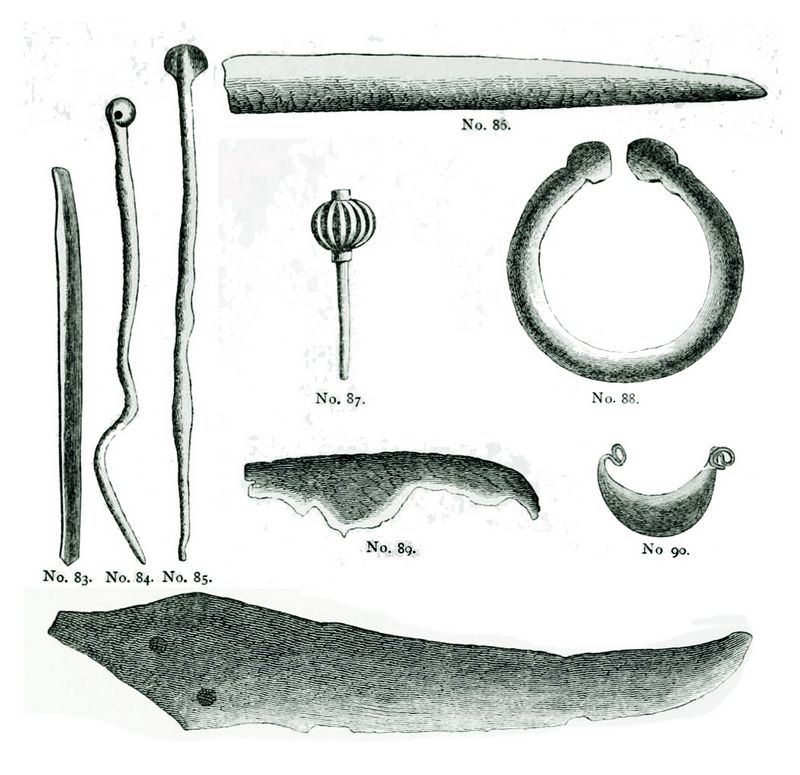
Figs. 83-91: Objects of Metal from the Lowest
Stratum (11-15 M.). No. 83. A real Copper Nail. Nos. 84, 85. Copper
Dress-Pins (too long and thin for nails). No. 86. A gilt Copper Knife.
No. 87. A Silver Dress-Pin. No. 88. A Copper Bracelet. Nos. 89, 91.
Copper Knives. No. 90. A Silver Crescent.
Were
it not for the splendid terra-cottas which I find exclusively upon the
primary soil and as far as 6½ feet above it, I could swear that, at a
depth of from 8 meters down to exactly 10 meters (26 to 33 feet), I am
among{149} the ruins of the Homeric Troy.[153] For at this depth I have
again found, as I foun
d last year, a thousand wonderful objects;
whereas I find comparatively little in the lowest stratum, the removal
of which gives me such unspeakable trouble.
We daily find some of the
whorls of very fine terra-cotta, and it is curious that those which
have no decorations at all, are always of the ordinary shape and size
of small tops or like the craters of volcanoes, while almost all those
possessing decorations are flat and in the form of a wheel.[154]
Metals, at least gold, silver and copper, were known to the Trojans (figs.83-91),
for I found a copper knife highly gilded, a silver hair-pin, and a
number of copper nails at a depth of 14 meters (46 feet); and at a
depth of 16 meters (52½ feet) several copper nails from 4 to 6¼ inches
in length.
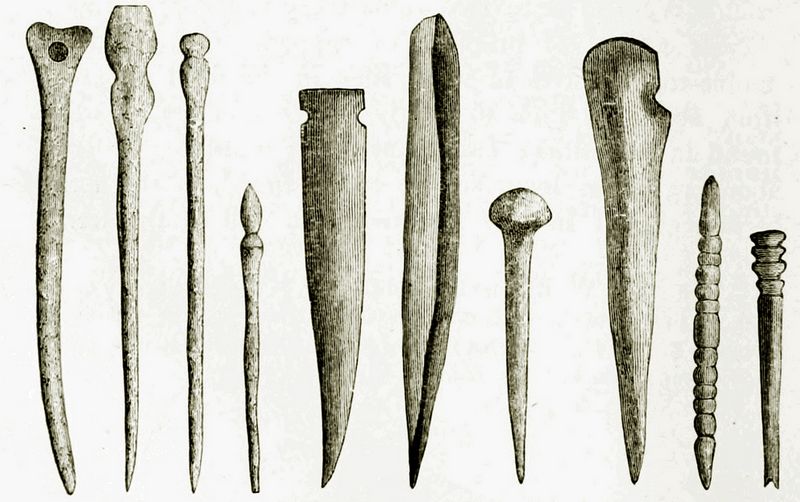 Figs.92-101: Ivory Pins, Needles, &c., from the Lowest Stratum (11-15 m depth).
There must have been also copper weapons and tools for work,
though I have as yet not found any; but I found many small instruments
for use as pins; also a number of ivory needles (figs. 92-101), likewise a small ivory
plate, almost the shape of a playing-card, with six little stars or
small suns, also a curious piece of ivory covered with the same
decorations, in the form of a paper-knife, and a still more curious one
in the form of an exceedingly neat dagger.[155] The ornaments on both
sides of this dagger seem certainly to represent the Ilian Athena with
the owl’s head.
We also discovered some ivory and copper rings,
likewise a pair of bracelets of copper. One-edged or double-edged
knives of white silex in the form of saws, from above 1¾ inch to nearly
2 inches in length, were found in quantities; also many hand millstones
of lava about 13 inches long, and 6-2/3 inches broad, in the form of an
egg cut in half longitudinally. All of the terra-cottas{150}{151}{152}
were brought out in a broken condition; however, I have got all or
almost all the pieces of a number of vases and of several jars, so that
I can restore them. I must specially mention a large yellowish bowl
13-1/3 inches high and nearly 17 inches broad, which in addition to a
handle has three large curled ram’s horns; then a black vase with a
round bottom, with two rings on either side for hanging it up; a
beautiful red vase with four handles; also a very fine red cup:
further, an exceedingly curious red vessel in the form of two jugs with
long perfectly upright beak-shaped mouths, the two jugs being connected
with each other at the bulge, as well as by a handle (fig.105); further, a
brilliant black vase, 9½ inches high, with rings on the sides for
hanging it up, and a very wide neck in the form of a chimney; the lower
portion of the vase is ornamented with signs in the form of lightning,
the upper part with dots (fig.106). Of a pair of brilliant black Trojan deep
plates I have so nearly all the pieces, as to be able to put them
together; these plates are very remarkable, for on two sides at the
edge they have long horizontal rings for suspension by{153} strings;
the large dishes have such rings very large. I have the fragments of
several black double cups, but not enough of any one to restore it.
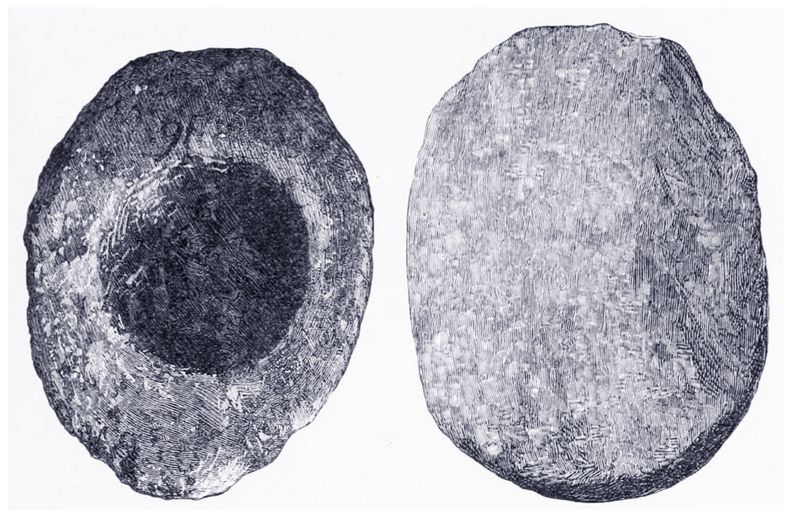
Figs.102,103: Hand Mill-stones of Lava from Lowest Stratum (14-16 m depth).
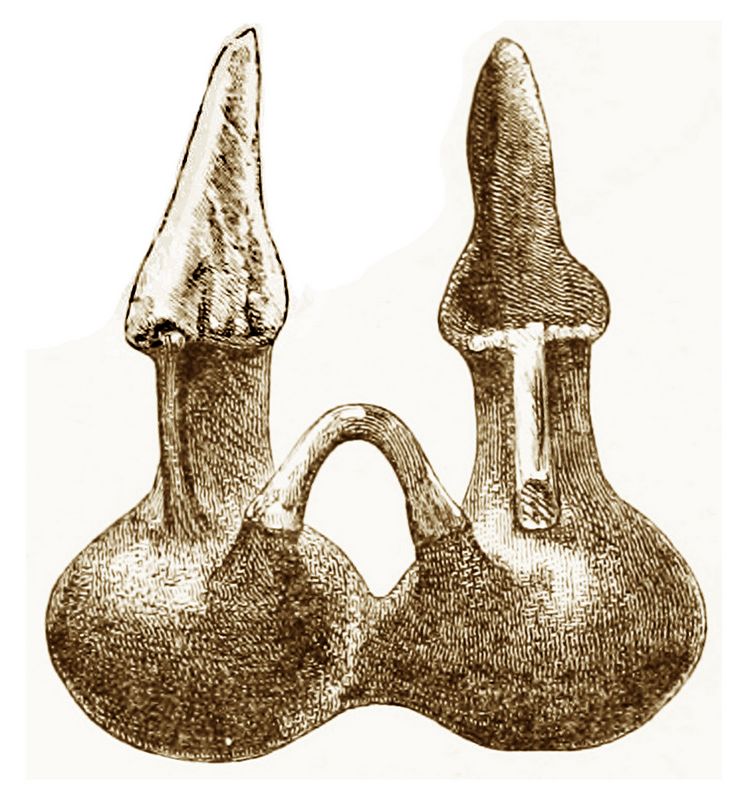
Fig.104: A splendid Vase with Suspension-rings, from the Lowest Stratum (15m depth).

Fig.105: Singular Double Vase from the lowest Stratum (13-14m depth).
Fig.106: Black Vase of Terra-cotta from the lowest Stratum (14 or 15m depth.).
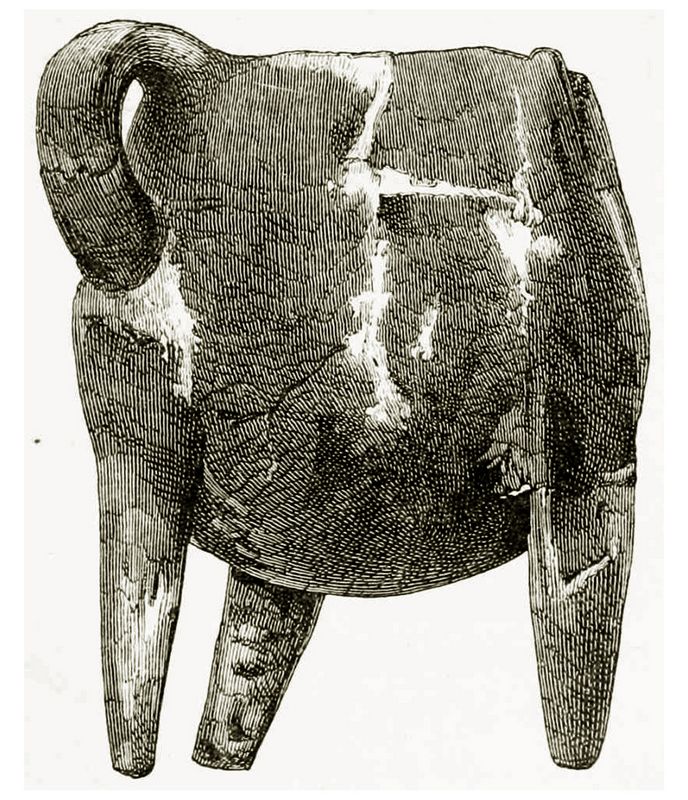
Fig.107: Funereal Urn of Stone, found on the Primary Rock, with Human Ashes in it (15½ m depth).
Unfortunately,
the tremendous weights of stone in the lowest stratum have broken or
crushed to pieces all the terra-cottas; but all the splendid earthen
vessels that I have been able to save bear witness of wealth and art,
and it is easily seen at a first glance that they were made by a people
quite distinct from the one to which the next stratum belongs (at the
depth of from 7 to 10 meters, 23 to 33 feet). I must draw especial
attention to the great similarity in the quality of the terra-cotta of
the black Trojan vessels to that of the vessels found in the Etruscan
tombs; but their forms and decorations are wholly different. In those
found here the patterns have always been engraved upon the clay when it
was still in a soft state.
Most of the Trojan terra-cottas are
indestructible by moisture; some of them, however, have become limp by
damp, and I found, for instance, upon the primary soil at a depth of
15½ meters (51 feet), in a small private burial-ground, formed and
protected by three stones 25½ inches long and 18 inches broad, two
vessels of a very remarkable form with three long feet and filled with
human ashes (fig.107). The vessels had suffered so from moisture that in spite of
every care and precaution I could not get them out without breaking
them completely. I have, however, collected all the pieces{154} of both
vessels, and shall be able to restore them. In one of them I found
among the human ashes the bones of an embryo of six months, a fact
which I can only explain by the mother’s having died in pregnancy and
having been burnt, while the bones of the embryo, being surrounded by
the membrane which enclosed it, were protected and remained uninjured.
Yet it seems wonderful that these small bones should have been
preserved, for the bones of the mother are burnt to ashes and I found
only mall fragments of them. I have most carefully collected the bones
of the Trojan embryo, and shall have the little skeleton restored by a
skilful surgeon. The celebrated Doctor Aretaios, of Athens, has just
written to me that the preservation of the bones of the embryo is only
possible on the supposition that the mother had brought forth the child
and then died, that her body was burnt and the unburnt embryo was put
into the funereal urn with her ashes, where I found it.
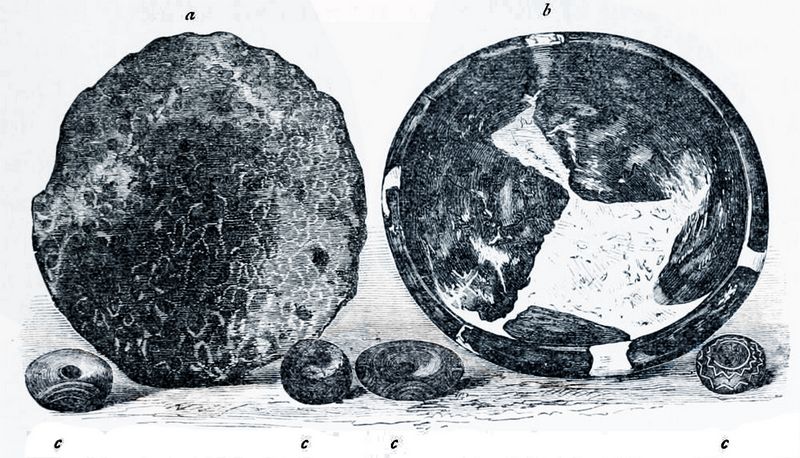
Fig.108: a, Hand Millstone of Lava (15m depth). b, Brilliant black Dish with
side Rings for hanging it up (14m depth). c,c,c,c, Small decorated Rings of
Terra-cotta (10-14m depth).
In
the deepest strata we also meet with simple black cups, resembling our
drinking-glasses; likewise black cups (vase-covers) with a handle
below, so that they can only stand upon their mouth. I also find on the
primary soil weights made of granite, the exact specific weights of
which I shall state in a separate table;[156] hammers and axes, as well
as a number of large and small wedges of diorite, of splendid
workmanship; sometimes also small beautifully-cut instruments in the
form of wedges, made of very beautiful transparent green stone.[157]
Besides these, we come upon quantities of round black and red
terra-cotta discs, generally nearly 2 inches in diameter, with a hole
in the centre; and stone quoits (d?s???), about 6 inches in diameter,
with a hole in the centre for throwing them. Further, a number of idols
of very fine marble, which form the only exception to the rule that at
an increasing depth the objects are of{155} much better workmanship
than those above. In fact, the idols met with in the Trojan
[pre-Trojan] strata of débris from 2 to 4 meters (6½ to 13 feet) above
the primary soil, that is, at a depth of from 12 to 14 meters (39¼ to
46 feet), are so coarsely wrought, as may be seen from the drawings (on
page 36), that one might be inclined to believe that they were the very
first attempts of an uncivilized people at making plastic
representations of a deity. There was only one mutilated idol of
terra-cotta found among these ruins, a drawing of which I give; all the
others are of very fine marble. I must also mention another Priapus, of
fine marble, which was discovered at a depth of 13 meters (42½ feet).
In
these depths we likewise find many bones of animals, boars’ tusks,
small shells, horns of the buffalo, ram, and stag; as well as the
vertebræ of the shark.
Footnotes:
[149]
Some examples of these jars, still more interesting on account of the
great depth at which they were found, are seen in Plate XI., p. 290.
[150] Chapter VIII.
[151]
For a further description and discussion of this splendid relief, see
the Introduction, see p. 32-34. An acute critic has suggested to us
that the metopé is a sculpture of the best age of Greek art, before or
about the time of Alexander, inserted in a Doric frieze of late debased
work, as is proved by the difference of styles, and by the evident fact
that the metopé was originally too large for the space between the
triglyphs. The temple to which it belonged, in Dr. Schliemann’s final
opinion, was a temple of Apollo, which he discovered later (comp. Chap.
XIV., p. 223, and Chap. XVII., p. 257).—[Ed.]
[152] Iliad, VI. 302-304:—
Ἡ δ’ ἄρα πέπλον ἑλοῦσα Θεανὼ καλλιπάρῃος
Θῆκεν Ἀθηναίης ἐπὶ γούνασιν ἠϋκόμοιο,
Εὐχομένη δ’ ἠρᾶτο Διὸς κούρῃ μεγάλοιο.
“But fair Theano took the robe and placed
On Pallas’ knees, and to the heavenly maid,
Daughter of Jove, she thus addressed her prayer.”
[153]
The reader should bear in mind that Dr. Schliemann finally came back to
this opinion. It is not “second thoughts” (say the authors of ‘Guesses
at Truth'), but first and third thoughts, that are “best.”—[Ed.]
[154] Compare the sections shown on Plate XXI.
[155] See No. 14, on page 36.
[156] At the end of the volume, see p. 359, 360.
[157] Dr. Schliemann afterwards pronounced these “wedges” to be battle-axes. See Introduction, p. 21.
[Continue to Chapter 10, part B]
|
|